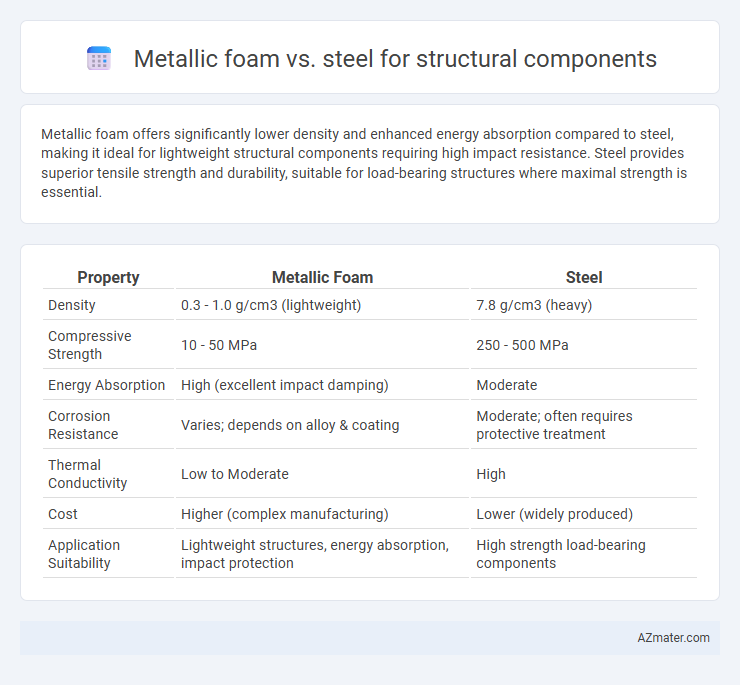Metallic foam offers significantly lower density and enhanced energy absorption compared to steel, making it ideal for lightweight structural components requiring high impact resistance. Steel provides superior tensile strength and durability, suitable for load-bearing structures where maximal strength is essential.
Table of Comparison
| Property | Metallic Foam | Steel |
|---|---|---|
| Density | 0.3 - 1.0 g/cm3 (lightweight) | 7.8 g/cm3 (heavy) |
| Compressive Strength | 10 - 50 MPa | 250 - 500 MPa |
| Energy Absorption | High (excellent impact damping) | Moderate |
| Corrosion Resistance | Varies; depends on alloy & coating | Moderate; often requires protective treatment |
| Thermal Conductivity | Low to Moderate | High |
| Cost | Higher (complex manufacturing) | Lower (widely produced) |
| Application Suitability | Lightweight structures, energy absorption, impact protection | High strength load-bearing components |
Introduction to Structural Materials: Metallic Foam vs Steel
Metallic foam offers a lightweight alternative to traditional steel for structural components, leveraging its high strength-to-weight ratio and energy absorption properties. Steel remains a dominant structural material due to its superior tensile strength, durability, and well-established fabrication techniques. Comparing both materials involves evaluating factors such as mechanical performance, density, corrosion resistance, and cost-efficiency in various engineering applications.
Composition and Manufacturing Processes
Metallic foam is primarily composed of metals like aluminum or titanium integrated with gas-filled pores, providing a lightweight structure with high energy absorption. Steel, an alloy mainly of iron and carbon, is manufactured through processes such as casting, rolling, and heat treatment to achieve high strength and durability. Manufacturing metallic foam involves techniques like powder metallurgy, foaming agents, or gas injection, which create a porous architecture contrasting with the dense microstructure produced by conventional steel fabrication methods.
Mechanical Properties Comparison
Metallic foam exhibits significantly lower density compared to steel, resulting in a superior strength-to-weight ratio and enhanced energy absorption capacity, which is advantageous for impact-resistant structural components. Steel, however, offers higher absolute tensile and compressive strength along with superior fatigue resistance, making it more suitable for load-bearing applications requiring long-term durability. The choice between metallic foam and steel depends on specific mechanical property requirements such as stiffness, weight reduction, and energy dissipation in the intended structural application.
Weight and Density Considerations
Metallic foam offers significantly lower density, typically ranging from 0.4 to 1.0 g/cm3, compared to steel's density of approximately 7.85 g/cm3, resulting in substantial weight savings for structural components. This reduction in weight leads to improved fuel efficiency and ease of handling in applications such as aerospace and automotive industries. Steel, while much denser and heavier, provides higher strength and stiffness, making it suitable for load-bearing structural elements where weight is less critical.
Energy Absorption and Impact Resistance
Metallic foam outperforms steel in energy absorption and impact resistance due to its highly porous structure, which efficiently dissipates kinetic energy and reduces peak loads during collisions. Steel offers superior strength and durability but lacks the deformation capability found in metallic foam that enables higher impact energy absorption. Engineers often select metallic foam for lightweight impact-resistant applications requiring enhanced energy damping, while steel remains favored for high-load structural integrity.
Corrosion Resistance and Durability
Metallic foam offers superior corrosion resistance compared to traditional steel due to its inherent porous structure and protective oxide layer, reducing the risk of rust formation in harsh environments. Steel, though strong and widely used, is prone to corrosion without proper coatings or treatments, which can compromise its durability over time. The enhanced corrosion resistance of metallic foam contributes to longer-lasting structural components, especially in applications exposed to moisture or chemical agents.
Cost Analysis and Economic Viability
Metallic foam offers significant weight reduction compared to traditional steel, resulting in lower transportation and handling costs, but its higher initial manufacturing expenses can outweigh these savings in large-scale projects. Steel remains more economically viable due to its well-established production processes, abundant availability, and lower material costs, making it a preferred choice for budget-sensitive structural components. Cost analysis reveals metallic foam's advantage in specialized applications where weight savings translate to operational efficiencies, while steel dominates in overall cost-effectiveness for standard structural use.
Applications in Construction and Engineering
Metallic foam offers exceptional lightweight properties and excellent energy absorption, making it ideal for seismic damping and impact-resistant structural components in construction and engineering. Steel, known for its high tensile strength and durability, remains the preferred material for load-bearing frameworks and reinforced structures requiring substantial mechanical support. Integration of metallic foam with steel can optimize structural performance by combining energy dissipation capabilities with robust strength in advanced engineering applications.
Sustainability and Environmental Impact
Metallic foam offers significant sustainability advantages over traditional steel in structural components due to its lightweight nature, which reduces material consumption and lowers transportation emissions. The high energy absorption and thermal insulation properties of metallic foam contribute to enhanced energy efficiency and longer service life, minimizing the need for frequent replacements. Steel production generates higher carbon emissions and energy use compared to metallic foam manufacturing, making metallic foam a more environmentally friendly alternative for sustainable construction.
Future Trends in Structural Component Materials
Metallic foam offers lightweight properties with excellent energy absorption, making it a promising alternative to traditional steel in structural components. Future trends indicate increasing integration of metallic foam composites enhanced by additive manufacturing for customized strength-to-weight ratios and improved corrosion resistance. Developments in nano-engineered foams and hybrid metal matrix composites are expected to further optimize mechanical performance and sustainability in construction and automotive industries.

Infographic: Metallic foam vs Steel for Structural component
 azmater.com
azmater.com